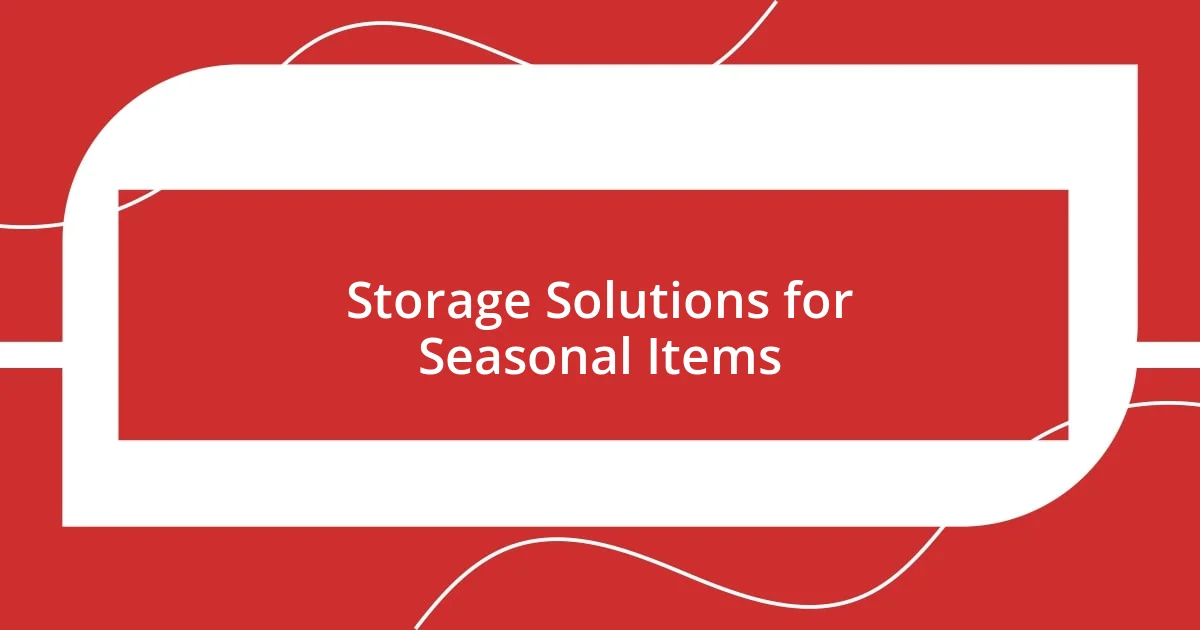Key takeaways:
- Understand seasonal clothing needs by adapting wardrobes to both weather changes and personal activities, while also reflecting on moods associated with different seasons.
- Evaluate your wardrobe by categorizing items, recognizing what fits and brings joy, and letting go of items that no longer align with your current style.
- Implement effective storage solutions, such as clear bins and labeled categories, to streamline seasonal transitions and make organization enjoyable and efficient.

Understanding Seasonal Clothing Needs
Understanding our seasonal clothing needs is like tuning into the rhythm of nature. I recall a time I found myself digging through a pile of sweaters in mid-April, only to realize I was late to the spring wardrobe transition. Can you relate? It’s easy to lose track of time, but acknowledging the change in seasons can help us feel more comfortable and confident in what we wear.
As the temperature rises or falls, our clothing choices should reflect not only the weather but also our activities. I remember how my summer dresses would sit neglected during chilly months, just waiting for warmer days. Isn’t it crucial to adapt our wardrobes to our lifestyle, ensuring each piece serves its purpose?
It’s also worth considering how our mood can shift with the seasons. I always notice that when I prepare for autumn, the rich colors and cozy fabrics genuinely lift my spirits. Don’t you think there’s something fulfilling in dressing in harmony with what the season brings? Understanding our seasonal clothing needs allows us to embrace change and express ourselves in new ways.

Evaluating Your Current Wardrobe
Evaluating your current wardrobe is a crucial step in organizing your seasonal clothing. I often find inspiration in the simple act of trying on clothes I haven’t worn in months. It’s enlightening to see what still fits and what sparks joy. Have you ever held onto a piece just to realize it clashes with your current style? Recognizing these disconnects can free up space for new favorites that align with your present self.
As I sift through my clothes, I also consider the memories associated with certain items. Each piece tells a story, but not all stories need to continue in my wardrobe. I once had a lovely dress from a favorite vacation that I hardly wore again. Letting it go was almost cathartic, allowing room for something fresh and exciting. Don’t you think evaluating your wardrobe helps you curate a collection that genuinely reflects who you are today?
While evaluating your closet, it’s essential to categorize your clothing based on usage and seasons. This helps to gain a clearer picture of what you own and what you actually need. I like to create a simple table to visualize my findings, making the decision process more straightforward and less overwhelming.
| Category | Examples |
|---|---|
| Everyday Essentials | Jeans, T-shirts, Sneakers |
| Seasonal Items | Swimsuits, Winter Coats |
| Sentimental Pieces | Prom Dress, Travel Souvenirs |
| Trendy Items | Belt Bag, Chunky Sweater |

Sorting Clothing by Season
Sorting clothing by season is a practical approach that I find refreshing. When I start the process, I pull everything out and lay it all on my bed. It’s like unveiling a treasure trove of memories and choices. I come across my favorite summer shorts – blissful reminders of beach days and barbecues. But then, I also find those bulky winter sweaters that seem like they were from another lifetime. I let myself reflect on how often I wore each item last season. This critical thinking helps me prioritize what to keep and what to let go.
Here’s how I typically sort my clothing:
- Spring/Summer: Light dresses, shorts, and breathable fabrics.
- Autumn/Winter: Cozy sweaters, thick coats, and thermal wear.
- Transitional Pieces: Items that work for multiple seasons, like cardigans and layered outfits.
- Sentimental Favorites: Clothes I love even if they’re not seasonally appropriate, like that concert T-shirt that holds a memory.
By keeping a keen eye on these categories, I ensure I’m ready for any season while also celebrating my unique style. It’s empowering to make choices that resonate with my current lifestyle.

Cleaning and Repairing Clothing
When it comes to cleaning my seasonal clothing, I don’t just throw everything into the washing machine. I pay attention to the fabric care labels, which are like little guides for keeping my clothes looking pristine. For instance, I recently discovered that my cozy wool sweater needed hand washing to maintain its softness. Have you ever faced the heartbreak of shrinking your favorite piece? I learned my lesson the hard way, and now I treat each garment with the care it deserves.
Repairing clothing is another aspect I find deeply rewarding. I remember a time when my beloved jeans developed a small tear near the pocket. Instead of tossing them, I took a moment to sew it up. Not only did I save money, but I also felt a sense of achievement every time I wore them afterward. Have you ever fixed something yourself? It’s amazing how such small efforts can breathe new life into your wardrobe and make you appreciate your favorite pieces even more.
Finally, I always keep a small repair kit handy with essential items like needles, threads, and fabric patches. Last winter, I faced a snag on my favorite scarf and was relieved to have the tools to fix it quickly. It allowed me to wear it right away without needing a trip to the tailor. Isn’t it satisfying to know you can handle these little hiccups yourself? This practice not only prolongs the life of my clothing but also gives me a sense of empowerment as I engage in the care and maintenance of my personal style.

Storage Solutions for Seasonal Items
When it comes to storing my seasonal items, I’ve found that using clear plastic bins has made a world of difference. I can easily see what’s inside, which prevents me from fumbling around and getting frustrated during a last-minute wardrobe change. I still remember the first time I switched from cardboard boxes to these bins – it was like organizing my life in one fell swoop. Have you ever experienced that satisfying moment when everything simply clicks into place? It’s freeing to have a systematic storage solution that fits seamlessly into my routine.
In addition to bins, I love utilizing vacuum-sealed bags for bulky winter coats and quilts. Not only do they save space, but they also protect my precious items from dust and moisture. Just last season, I packed away my oversized winter coat, which took up half my closet. When I retrieved it months later, it felt like a surprise gift I had forgotten about – all warm and ready for cold weather again! Isn’t it intriguing how a little ingenuity with storage can refresh your excitement for your wardrobe?
Finally, I like to label my bins for easy reference. A simple label maker or even handwritten notes can save me time and hassle. Last summer, I decided to create categories not only by season but also by type, like “swimwear” and “light jackets.” This organizational strategy might sound a bit obsessive, but let me tell you, it’s incredibly satisfying to easily find what I need without rummaging through piles. Do you think you’d feel the same thrill in a well-organized closet? I know I do! It’s like creating a personal sanctuary where every item has its place, leading to a more effortless and enjoyable dressing process each season.

Labeling and Organizing Storage Bins
Labeling my storage bins adds a sense of order to my closet that I honestly cherish. I remember the first time I labeled my bins, I used colorful tape and a marker to categorize them. It was like a mini art project! Now, every time I open that closet, I feel a small rush of satisfaction knowing that I can grab exactly what I need without diving into chaos. Have you ever opened a bin only to find it full of unexpected items? That’s a mystery I prefer to avoid.
I swear by creating specific labels that not only name the contents but also provide a little detail about them. For example, instead of just labeling a bin “Winter Coats,” I include “If frozen, heat to wear!” Such playful annotations make the process feel personal and fun. I still chuckle at the reminder I wrote last winter after battling my way through a storage fight to find my favorite down jacket. Can you relate to feeling like you’ve gone into battle with your closet?
Transferring my labeling method to bins meant I could delve deeper into organizing. I also started creating a seasonal checklist for when I switch out my clothes. This way, I keep track of what I have and what I might need for the next season, ensuring that no beloved item stays hidden for too long. There’s something incredibly gratifying about knowing that my clothes aren’t just stored away; they’re part of a system that I’ve crafted. Isn’t it heartening to know you have everything managed—both for organization and for the inevitable seasonal switch?

Tips for Quick Seasonal Transitions
Transitioning between seasons doesn’t have to be a hassle; a few smart strategies can truly streamline the process. One approach I love is to create a designated transition day each season. I set aside a few hours to swap out my clothing, and it makes the task feel more like a mini event rather than a chore. I often put on some music, pour myself a cup of tea, and embrace the whole experience. Doesn’t it feel more enjoyable when you can turn a mundane task into something a bit more special?
An essential tip that I’ve discovered is to keep an ongoing seasonal swap checklist. I jot down what items to pack away and what to bring out. This way, I avoid that sinking feeling of realizing an essential piece is still hiding somewhere in a dark corner. Recently, my list helped me remember my beloved pair of autumn boots that I tend to overlook. Can you relate to that feeling of triumph when you rediscover something just in time?
Lastly, I recommend evaluating your clothing during each transition. As I pull out my seasonal items, I always take a moment to assess what I actually wore the previous season. If something hasn’t been worn in a few cycles, it’s time to consider donating it. This practice not only clears out my closet but also keeps my wardrobe feeling fresh and exciting. Honestly, is there anything better than starting a new season with a wardrobe that genuinely reflects your current style?















